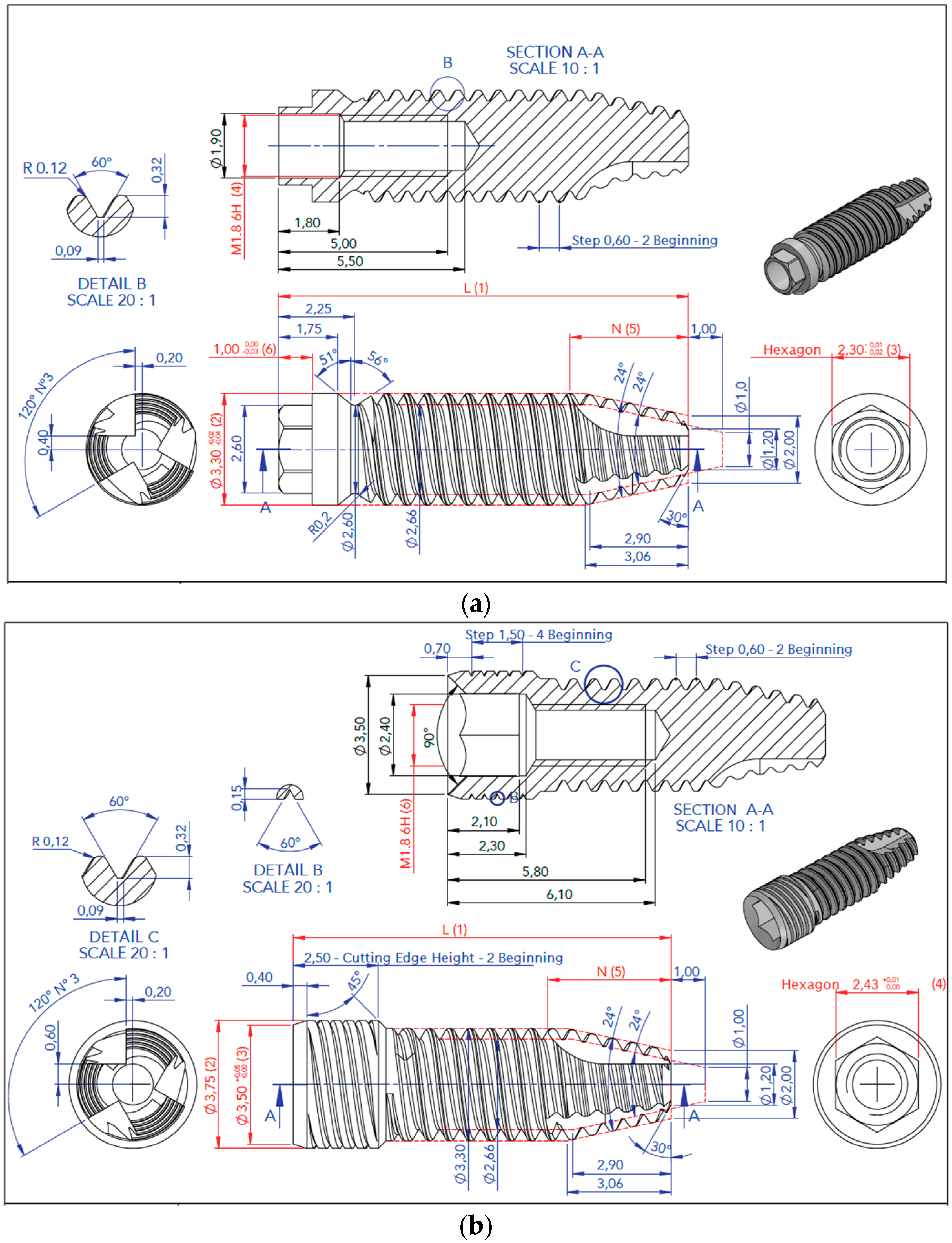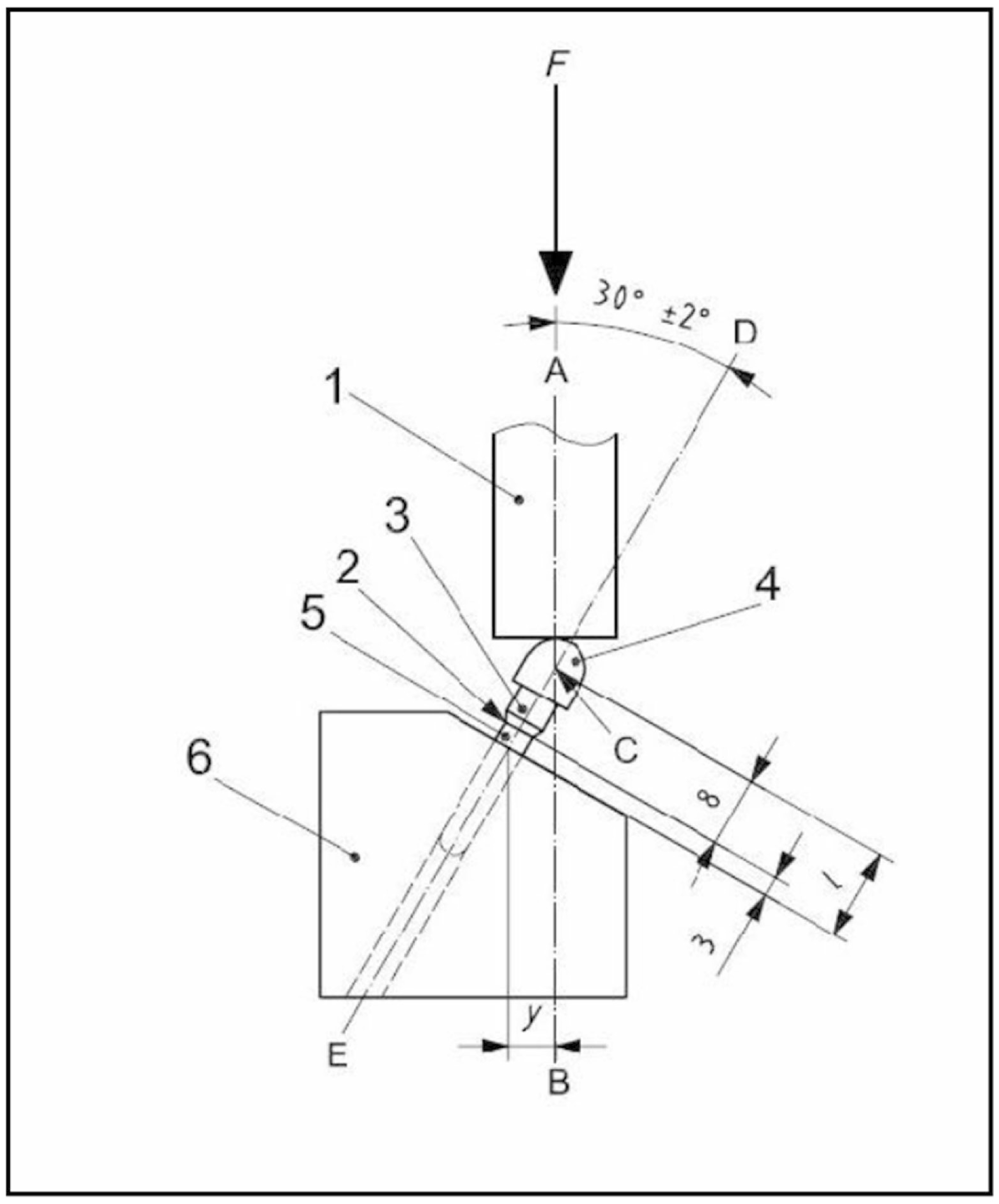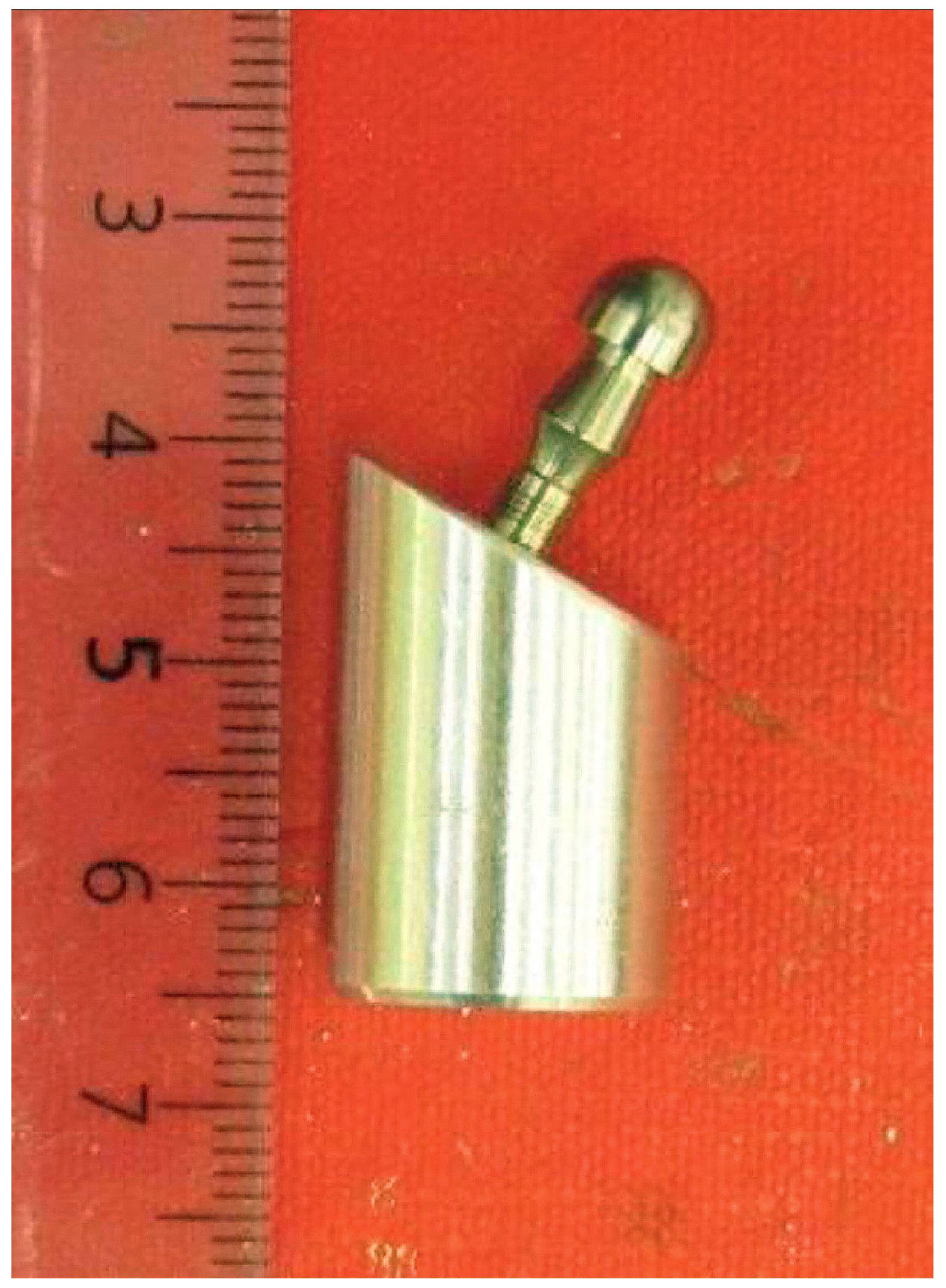External Connection versus Internal Connection in Dental Implantology. A Mechanical in vitro Study
Abstract
1. Introduction
2. Materials and Methods
2.1. Static Characterisation
2.2. Characterisation with Dynamic Load
2.3. Dimensional Characterisation after the Dynamic Load Study
2.4. Statistical Analysis
3. Results
3.1. Static Characterisation
3.2. Dynamic Stress Characterisation
3.3. Dimensional Characterisation
4. Discussion
5. Conclusions
Author Contributions
Funding
Conflicts of Interest
References
- Holm-pedersen, P.; Lang, N.P.; Müller, F. What are the longevities of teeth and oral implants? Clin. Oral Implant. Res. 2007, 18, 15–19. [Google Scholar] [CrossRef] [PubMed]
- Bogaerde, L.V.; Rangert, B.; Wendelhag, I. Immediate/early function of Bränemark System TiUnite implants in fresh extraction sockets in maxillae and posterior mandibles: An 18-month prospective clinical study. Clin. Implant. Dent. Relat. Res. 2005, 7, S121–S130. [Google Scholar] [CrossRef]
- Cornelini, R.; Cangini, F.; Covani, U.; Wilson, Jr.; Thomas, G. Immediate restoration of implants placed into fresh extraction sockets for single-tooth replacement: A prospective clinical study. Int. J. Periodontics Restor. Dent. 2005, 25, 439–447. [Google Scholar] [CrossRef]
- Chrcanovic, B.R.; Martins, M.D.; Wennerberg, A. Immediate placement of implants into infected sites: A systematic review. Clin. Implant. Dent. Relat. Res. 2015, 17, e1–e16. [Google Scholar] [CrossRef] [PubMed]
- Corbella, S.; Taschieri, S.; Tsesis, I.; Del Fabbro, M. Postextraction implant in sites with endodontic infection as an alternative to endodontic retreatment: A review of literature. J. Oral Implantol. 2013, 39, 399–405. [Google Scholar] [CrossRef] [PubMed]
- Álvarez-Camino, J.C.; Valmaseda-Castellón, E.; Gay-Escoda, C. Immediate implants placed in fresh sockets associated to periapical infectious processes. A systematic review. Med. Oral Patol. Oral Cir. Bucal 2013, 18, e780. [Google Scholar] [CrossRef] [PubMed]
- Schwarz, M.S. Mechanical complications of dental implants. Clin. Oral Implant. Res. 2000, 1, 156–158. [Google Scholar] [CrossRef]
- Branemark, P.I.; Zarb, G.; Albrektsson, T. Tissue-Integrated Prostheses. In Osseointegration in Clinical Dentistry, 1st ed.; Quintessence Publishing Co.: Chicago, IL, USA, 1985; pp. 11–76. [Google Scholar]
- Maeda, Y.; Satoh, T.; Sogo, M. In vitro differences of stress concentrations for internal and external hex implantabutment connections: A short communication. J. Oral Rehabil. 2006, 33, 75–78. [Google Scholar] [CrossRef] [PubMed]
- Sutter, F.; Weber, H.P.; Sorensen, J.; Belser, U. The new restorative concept of the ITI dental implant system: Design and engineering. Int. J. Periodontive Res. Dent. 1993, 13, 409–431. [Google Scholar]
- Menini, M.; Pesce, P.; Bagnasco, F.; Carossa, M.; Mussano, F.; Pera, F. Evaluation of internal and external hexagon connections in immediately loaded full-arch rehabilitations: A within-person randomised split-mouth controlled trial. Int. J. Oral Implantol. 2019, 12, 169–179. [Google Scholar]
- Caricasulo, R.; Malchiodi, L.; Ghensi, P.; Fantozzi, G.; Cucchi, A. The influence of implant-abutment connection to peri-implant bone loss: A systematic review and meta-analysis. Clin. Implant. Dent. Relat. Res. 2018, 20, 653–664. [Google Scholar] [CrossRef] [PubMed]
- Mishra, S.K.; Chowdhary, R.; Kumari, S. Microleakage at the different implant abutment interface: A systematic review. J. Clin. Diagn. Res. 2017, 11, ZE10–ZE15. [Google Scholar] [CrossRef] [PubMed]
- Gracis, S.; Michalakis, K.; Vigolo, P.; Vult von Steyern, P.; Zwahlen, M.; Sailer, I. Internal vs. external connections for abutments/reconstructions: A systematic review. Clin. Oral Implant. Res. 2012, 23, 202–216. [Google Scholar] [CrossRef]
- Vigolo, P.; Gracis, S.; Carboncini, F.; Mutinelli, S. AIOP (Italian Academy of Prosthetic Dentistry) clinical research group. Internal—vs external—connection single implants: A retrospective study in an italian population treated by certified prosthodontists. Int. J. Oral Maxillofac. Implant. 2016, 31, 1385–1396. [Google Scholar] [CrossRef] [PubMed]
- Dittmer, M.P.; Dittmer, S.; Borchers, L. Influence of the interface design on the yield force of the implant–abutment complex before and after cyclic mechanical loading. J. Prosthodont. Res. 2012, 56, 19–24. [Google Scholar] [CrossRef] [PubMed]
- UNE-EN ISO 14801:2016. Dentistry—Implants—Dynamic Loading Test for Endosseous Dental Implants; International Organozation for Standardization: Geneva, Switzerland, April 2017. [Google Scholar]
- Binon, P.P.; McHugh, M.J. The effect of eliminating implant/abutment rotational misfit on screw joint stability. Int. J. Prosthodont. 1996, 9, 511–519. [Google Scholar] [PubMed]
- Gratton, D.G.; Aquilino, S.A.l; Stanford, C.M. Micromotion and dynamic fatigue properties of the dental implant–abutment interface. J. Prosthet. Dent. 2001, 85, 47–52. [Google Scholar] [CrossRef]
- Papaspyridakos, P.; Mokti, M.; Chen, C.J.; Benic, G.I.; Gallucci, G.O.; Chronopoulos, V. Implant and prosthodontic survival rates with implant fixed complete dental prostheses in the edentulous mandible after at least 5 years: A systematic review. Clin. Implant. Dent. Relat. Res. 2014, 16, 705–717. [Google Scholar] [CrossRef]
- Pedroza, J.E.; Torrealba, Y.; Elias, A.; Psoter, W. Comparison of the compressive strength of 3 different implant design systems. J. Oral Implantol. 2007, 33, 1–7. [Google Scholar] [CrossRef]
- Steinebrunner, L.; Wolfart, S.; Ludwig, K.; Kern, M. Implant-abutment interface design affects fatigue and fracture strength of implants. Clin. Oral Implant. Res. 2008, 19, 1276–1284. [Google Scholar] [CrossRef]
- Strub, J.R.; Gerds, T. Fracture strength and failure mode of five different single tooth implant abutment combinations. Int. J. Prosthodont. 2003, 16, 167–171. [Google Scholar] [PubMed]
- Marchetti, E.; Ratta, S.; Mummolo, S.; Tecco, S.; Pecci, R.; Bedini, R.; Marzo, G. Mechanical reliability evaluation of an oral implant abutment system according to UNI EN ISO14801 fatigue test protocol. Implant. Dent. 2016, 25, 613–618. [Google Scholar] [CrossRef] [PubMed]
- Reis, J.; Reis, L.; Deus, A.M.; Bicudo, P.; Vaz, M.F. Mechanical behaviour of dental implants. Proced. Struct. Integr. 2016, 1, 26–33. [Google Scholar]
- Jemt, T.; Pettersson, P.A. 3-year follow-up study on single implant treatment. J. Dent. 1993, 21, 203–208. [Google Scholar] [CrossRef]
- Ekfeldt, A.; Carlsson, G.E.; Börjesson, G. Clinical evaluation of single-tooth restorations supported by osseointegrated implants: A retrospective study. Int. J. Oral Maxillofac. Implant. 1994, 9, 179–183. [Google Scholar]
- Goiato, M.C.; Pellizzer, E.P.; da Silva, E.V.; da Rcha Bonatto, L.; dos Santos, D.M. Is the internal connection more efficient than external connection in mechanical, biological, and esthetical point of views? A systematic review. Oral Maxillofac. Surg. 2015, 19, 229–242. [Google Scholar] [CrossRef]
- Malta Barbosa, J.; Navarro da Rocha, D.; Hirata, R.; Freitas, G.; Bonfante, E.; Coelho, P.G. Fatigue failure of external hexagon connections on cemented implant-supported crowns. Implant. Dent. 2018. [Google Scholar] [CrossRef]
- Helkimo, E.; Carlsson, G.E.; Helkimo, M. Bite forces used during chewing of food. J. Dent. Res. 1959, 29, 133–136. [Google Scholar]
- Waltimo, A.; Könönen, A. A novel bite force recorder and maximal isometric bite force values for healthy young adults. Eur. J. Oral Sci. 1993, 1001, 171–175. [Google Scholar] [CrossRef]
- Marchetti, E.; Ratta, S.; Mummolo, S.; Tecco, S.; Pecci, R.; Bedini, R.; Marzo, G. Evaluation of an endosseous oral implant system ccording to UNI EN ISO 14801 fatigue test protocol. Implant Dent. 2014, 23, 665–671. [Google Scholar]




| Group | Model | Type | Connection | Material | Diameter | Length |
|---|---|---|---|---|---|---|
| External | L6 | Cylindrical Implant | Hexagon-type connection; height: 0.7 mm, diameter: 2.7 mm | Ti Grade IV, cold worked | Ø 3.3 mm | 14.5 mm |
| Internal | L35 | Cylindrical Implant | Internal hexagon connection; diameter: 3.5 mm | Ti Grade V, ELI-2 | Ø 3.3 mm | 14.5 mm |
| Connection | Test Samples | Fmax (N) |
|---|---|---|
| External | N-1 | 986.1 |
| N-2 | 610.9 | |
| N-3 | 764.8 | |
| Total | 787.26 ± 188.60 | |
| Internal | N-1 | 1277.6 |
| N-2 | 1263.2 | |
| N-3 | 1324.0 | |
| Total | 1288.26 ± 31.77 |
| Variable | External | Internal | p | |||
|---|---|---|---|---|---|---|
| Average | Standard Deviation | Average | Standard Deviation | |||
| Bending moment (Nmm) | M avg | 898.26 | 6.00 | 604.10 | 16.50 | <0.001 |
| M dyn | 734.70 | 5.26 | 494.23 | 13.51 | <0.001 | |
| M max | 1630.20 | 7.11 | 1098.33 | 30.02 | <0.001 | |
| M min | 163.36 | 1.05 | 109.83 | 3.03 | <0.001 | |
| Compression stimulus (N) | CS avg | 142.53 | 0.15 | 94.93 | 0.45 | <0.001 |
| CS dyn | 116.70 | 0.10 | 77.66 | 0.35 | <0.001 | |
| CS max | 259.33 | 0.15 | 172.60 | 0.80 | <0.001 | |
| CS min | 25.90 | 0.00 | 17.26 | 0.05 | <0.001 | |
| F max (N) | 787.26 | 188.60 | 1288.26 | 31.77 | 0.011 | |
| Length (mm) (initially 11 mm (l in Figure 2)) | 10.84 | 0.09 | 10.87 | 0.15 | 0.768 | |
| Distance (mm) (initially 5.50 mm (y in Figure 2)) | 5.44 | 0.03 | 5.49 | 0.15 | 0.642 | |
| Angle (degrees) (initially 30 degrees, Figure 2) | 30.28 | 0.27 | 30.06 | 0.48 | 0.537 | |
© 2019 by the authors. Licensee MDPI, Basel, Switzerland. This article is an open access article distributed under the terms and conditions of the Creative Commons Attribution (CC BY) license (http://creativecommons.org/licenses/by/4.0/).
Share and Cite
Fernández-Asián, I.; Martínez-González, Á.; Torres-Lagares, D.; Serrera-Figallo, M.-Á.; Gutiérrez-Pérez, J.-L. External Connection versus Internal Connection in Dental Implantology. A Mechanical in vitro Study. Metals 2019, 9, 1106. https://doi.org/10.3390/met9101106
Fernández-Asián I, Martínez-González Á, Torres-Lagares D, Serrera-Figallo M-Á, Gutiérrez-Pérez J-L. External Connection versus Internal Connection in Dental Implantology. A Mechanical in vitro Study. Metals. 2019; 9(10):1106. https://doi.org/10.3390/met9101106
Chicago/Turabian StyleFernández-Asián, Ignacio, Álvaro Martínez-González, Daniel Torres-Lagares, María-Ángeles Serrera-Figallo, and José-Luis Gutiérrez-Pérez. 2019. "External Connection versus Internal Connection in Dental Implantology. A Mechanical in vitro Study" Metals 9, no. 10: 1106. https://doi.org/10.3390/met9101106
APA StyleFernández-Asián, I., Martínez-González, Á., Torres-Lagares, D., Serrera-Figallo, M.-Á., & Gutiérrez-Pérez, J.-L. (2019). External Connection versus Internal Connection in Dental Implantology. A Mechanical in vitro Study. Metals, 9(10), 1106. https://doi.org/10.3390/met9101106







